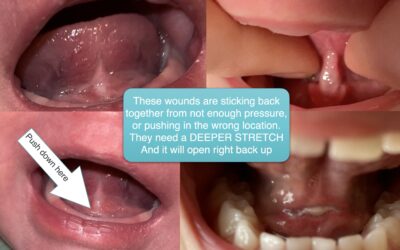We hear patients ask this question commonly, and there may be some confusion about it because some providers say that stretches are not needed, or are “overkill”. The worst part of having your child’s tongue-tie release is the stretches (because we make the procedure as quick and easy as possible). But without stretches, it will grow back together.
If a provider is going to treat a tongue-tie but has no plan for aftercare or follow-up, then it really shouldn’t be treated. If stretches are not recommended afterward to physically separate the area a couple of times a day, the lip-tie or tongue-tie wound will grow back together, possibly even tighter than before.
If a provider says stretches are not needed, they either did not remove enough tissue (a clip or a snip) or they did not get their patients back for follow up, or they would see that it grows back together.
All wounds contract. Just like if you get your ear pierced, you have to leave the earring in for 6 weeks, or it will grow back together, or you cut your hand, and it heals, this property of wound healing is super helpful 99% of the time. But in this case, when we are trying to lengthen the tissue, we want to “trick” it to heal open.
- Stretches involve physically lifting the tongue or lip to make sure it’s not sticking back together (reattachment/readhesion).
- Exercises involve the patient lifting their tongue and performing movements that are building blocks to swallowing, normal rest posture, etc.
Myofunctional therapy is the field of therapy and professionals who research and work with patients who are retraining their oral muscles (myo) and tongue function (functional) for patients who have oral dysfunction. We’ll do the next pearl on Myofunctional Therapy, but the three keys are to have the tongue rest up on the palate, the lips together, and breathing through the nose day and night.
If you’re a patient and have questions about stretches or becoming a patient at our office, call us at 205-419-4333, or contact us!
Our book Tongue-Tied goes into stretches, aftercare, proper release technique, and more, and for a limited time, we’re giving away our bestselling, 340pg book free to dentists and therapists.



